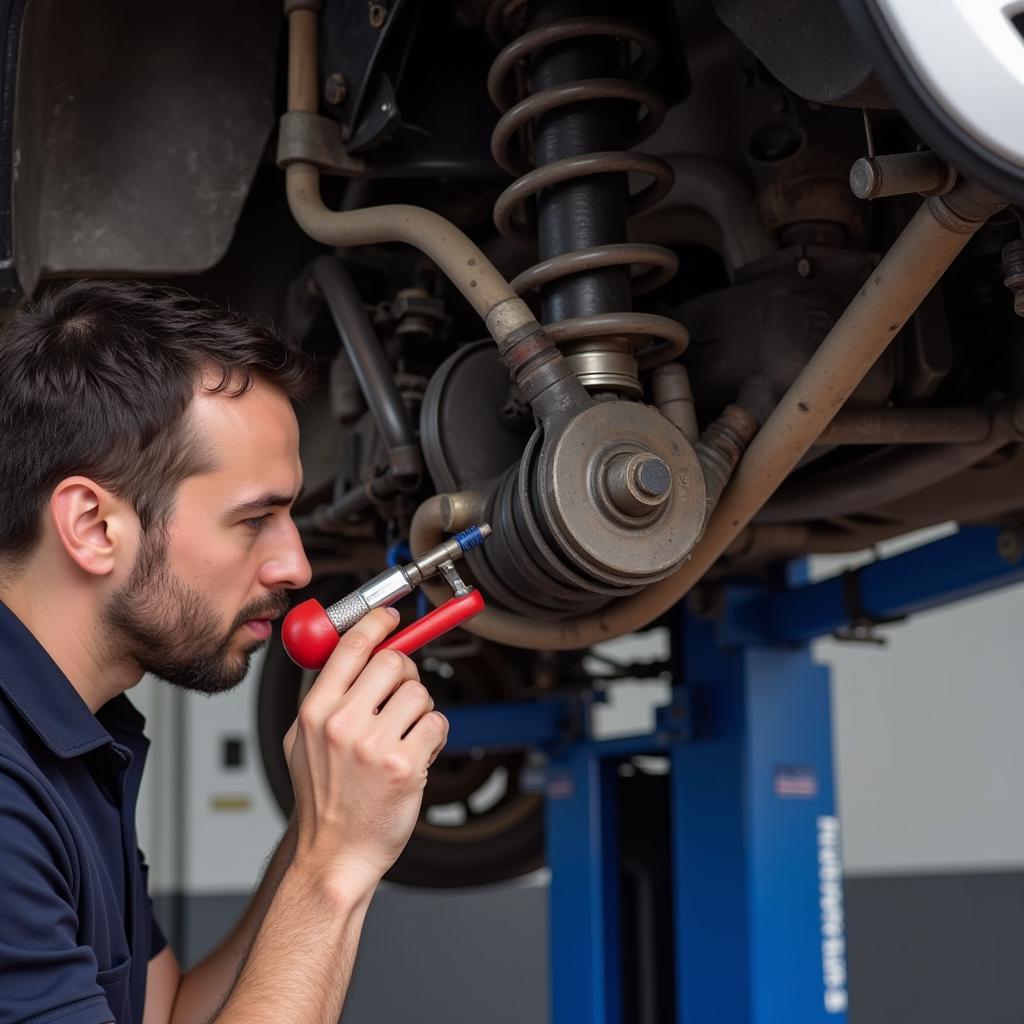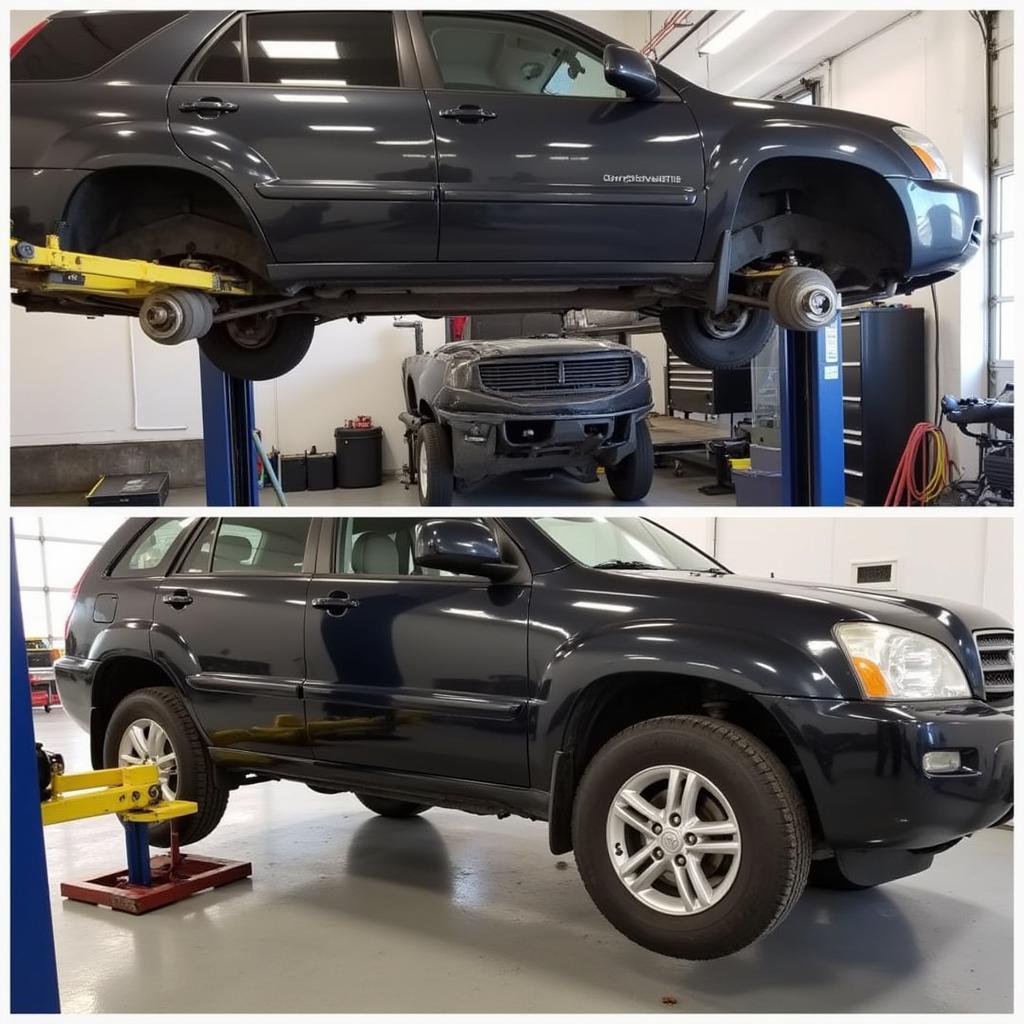Car Suspension Spring Problems can significantly impact your vehicle’s handling, ride comfort, and overall safety. Understanding the causes, symptoms, and solutions to these problems is crucial for any car owner, mechanic, or automotive technician. This guide provides a deep dive into everything you need to know about car suspension spring issues.
Dealing with a bouncy car? Check out our guide on car bumpy ride problem.
What Causes Car Suspension Spring Problems?
Several factors can contribute to car suspension spring problems. These range from normal wear and tear due to age and mileage to external factors like impacts from potholes or overloading the vehicle. Corrosion, especially in regions with harsh winters and road salt use, can weaken the springs and lead to premature failure. Incorrect installation or the use of substandard springs can also cause issues down the line. Finally, driving habits, such as frequently driving on rough terrain or aggressive driving, can accelerate wear and tear on the suspension components, including the springs.
Identifying Car Suspension Spring Problems: Symptoms to Watch Out For
Recognizing the symptoms of failing suspension springs is essential for timely intervention and preventing further damage. One of the most obvious signs is a noticeably rougher ride than usual. You might feel every bump and imperfection in the road. The car may also sit lower than normal, especially on one side if only one spring is affected. Other symptoms include unusual noises coming from the suspension, such as squeaking or clunking, and difficulty steering or controlling the vehicle, particularly when cornering. If you notice any of these signs, it’s crucial to have your suspension inspected by a qualified mechanic.
If your car is experiencing any of these problems, it might be related to your suspension. Learn more about identifying these issues at our car suspension problem symptoms page.
Diagnosing Car Suspension Spring Problems
While visual inspection can sometimes reveal obvious damage like a broken spring, a thorough diagnosis often involves a bounce test and a detailed inspection of all suspension components. The bounce test involves pushing down on each corner of the car and observing how it rebounds. A healthy suspension should return to its normal position quickly and smoothly. A worn-out spring or shock absorber will cause excessive bouncing or a slow return to normal ride height.
 Mechanic Inspecting Car Suspension
Mechanic Inspecting Car Suspension
Solutions for Car Suspension Spring Problems
In most cases, the solution to a car suspension spring problem is replacement. While repairing a broken spring might seem like a cost-effective option, it’s generally not recommended as it can compromise the spring’s integrity and create a safety hazard. Replacing the springs in pairs is often advisable, especially on the same axle, to ensure even ride height and handling. Using high-quality replacement springs and having them installed by a qualified mechanic is crucial for optimal performance and longevity.
“Replacing worn-out suspension springs is not just about restoring ride comfort; it’s about ensuring your safety on the road,” says Michael Davis, a veteran automotive engineer with over 20 years of experience.
Preventing Car Suspension Spring Problems
Regular maintenance is key to preventing car suspension spring problems. This includes periodic inspections of the suspension system, especially if you frequently drive on rough roads or carry heavy loads. Avoiding overloading the vehicle and driving carefully over potholes and other road hazards can also help extend the lifespan of your suspension springs.
Are you experiencing a bumpy ride and suspect it might be related to your suspension springs or dampers? Check out our in-depth guide car and road spring and damper problem constant horizontal speed.
Choosing the Right Replacement Springs
Selecting the appropriate replacement springs is essential for restoring your vehicle’s performance and handling. Factors to consider include the vehicle’s make and model, intended use, and desired ride characteristics. Consult with a qualified mechanic or refer to your vehicle’s owner’s manual for recommendations.
 New Car Suspension Springs
New Car Suspension Springs
“Choosing the right suspension springs is crucial for achieving optimal performance and ride comfort,” adds Sarah Miller, a certified mechanic and suspension specialist. “It’s essential to consider the vehicle’s specific requirements and driving conditions.”
Conclusion: Keeping Your Car’s Suspension in Top Shape
Car suspension spring problems can range from minor annoyances to serious safety concerns. By understanding the causes, symptoms, and solutions discussed in this guide, you can maintain your car’s suspension in optimal condition and ensure a safe and comfortable driving experience. Don’t hesitate to contact us at AutoTipPro at +1 (641) 206-8880 or visit our office at 500 N St Mary’s St, San Antonio, TX 78205, United States, for expert advice and assistance with your car suspension spring problems.
If you’re curious about other potential car problems, take a look at our resource on common issues with the 2006 Lincoln Town Car: 2006 lincoln town car signature problems.
 Car With New Suspension
Car With New Suspension
FAQs
-
How often should I have my car’s suspension inspected? It’s generally recommended to have your suspension inspected annually or every 12,000 miles.
-
Can I replace car suspension springs myself? While possible, it’s recommended to have a qualified mechanic handle suspension repairs due to the specialized tools and expertise required.
-
How much does it cost to replace car suspension springs? The cost varies depending on the vehicle make and model and the type of springs used.
-
What are the signs of a broken car suspension spring? Signs include a noticeably rougher ride, a leaning car, unusual noises from the suspension, and difficulty steering.
-
How long do car suspension springs last? The lifespan of car suspension springs varies but typically ranges from 40,000 to 70,000 miles.
-
What are the different types of car suspension springs? Common types include coil springs, leaf springs, and torsion bars.
-
Can driving habits affect the lifespan of car suspension springs? Yes, aggressive driving and frequently driving on rough terrain can shorten the lifespan of suspension components.







Leave a Reply